Iran is a magnificent country. With landscapes vastly different from north to south, east to west. Deserts of Iran are something that fascinates me, as it is a major part of the old Silk Road. Hence on our way from Shiraz to Isfahan, we made a stop in Yazd to explore this desert city of Iran.
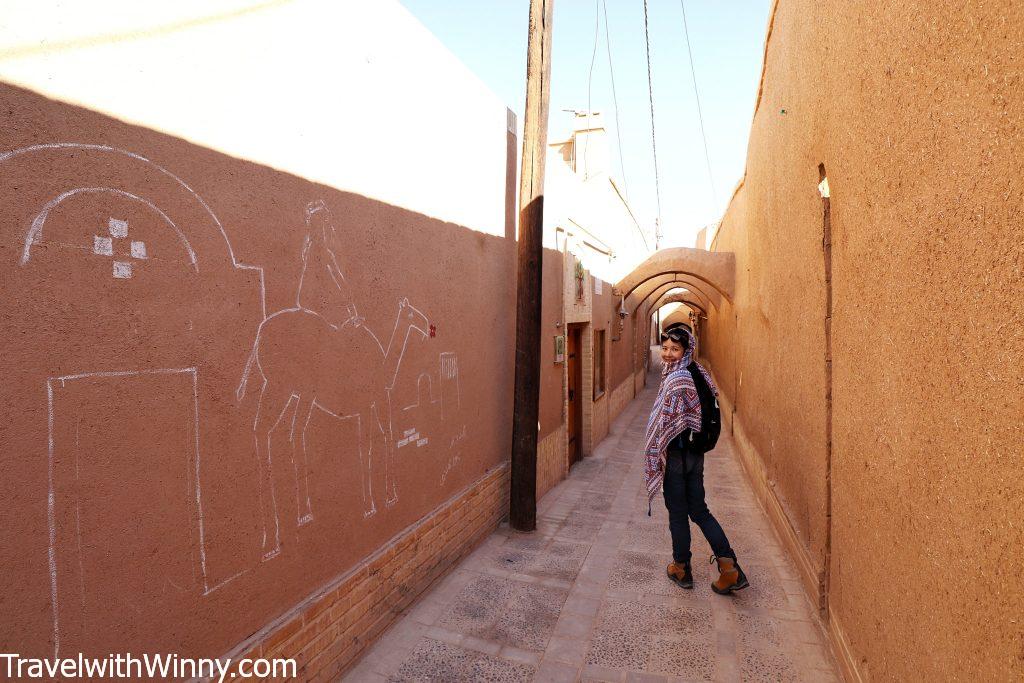
Walking through the old streets of Yazd.
Yazd is nicked named the “City of Windcatchers” as generations of people adapting to its desert surrounds. There are many unique features in this city, such as wind towers to cool down the buildings or “yakhchals” which are used to store ice retrieved from glaciers in the nearby mountains.

The two sisters that stopped to say hi.
It is an ancient city dating back to the Sassanian Period (224-651 AD), with its old town being recognized as UNESCO in 2017. In addition, it is one of the largest cities in the world built almost entirely out of adobe. It reminded me of the ancient city of Aït Benhaddou in Morocco that we visited a while ago, where parts of Game of Thrones and the movie Gladiator was filmed.
3 Main deserts of Iran
There are many different deserts and oases between Shiraz and Tehran. Personally, I think the best way to plan your trip is to see how much time you have in the country, as some of them can be quite off the beaten track.

Each desert in Iran has its unique selling points.
The Maranjab Desert
The Maranjab Desert is probably one of the most famous deserts in Iran. One of the unique selling points of this desert is that it has a large salt flat nearby. It is about 100KM from the holy city of Oam and 50KM from the desert oasis of Kashan. However, we didn’t end of choosing this desert because we have seen many salt lakes in Australia and wanted to see something different with our limited time in Iran.

The dried pink salt lake between Melbourne & Adelaide back in Australia.
The Varzaneh Desert
This desert contains the largest sand dune in Iran. In addition, it is only 100KM from Isfahan, which makes it a popular day trip option. It is also not far from the ancient mud town of Varzaneh. The town itself is over a thousand years old, with women wearing white veil instead of black ones.
在 Instagram 查看這則貼文
I have always wanted to visit a pigeon tower in Iran and there is one called Ghoortan Dovecote in Varzaneh. However, you can also find a pigeon tower in Isfahan (Mardavij Pigeon Tower). As we have already camped overnight in the Sahara Desert before, that’s why we didn’t opt for Varzaneh Desert and use the time to explore elsewhere in Isfahan instead.
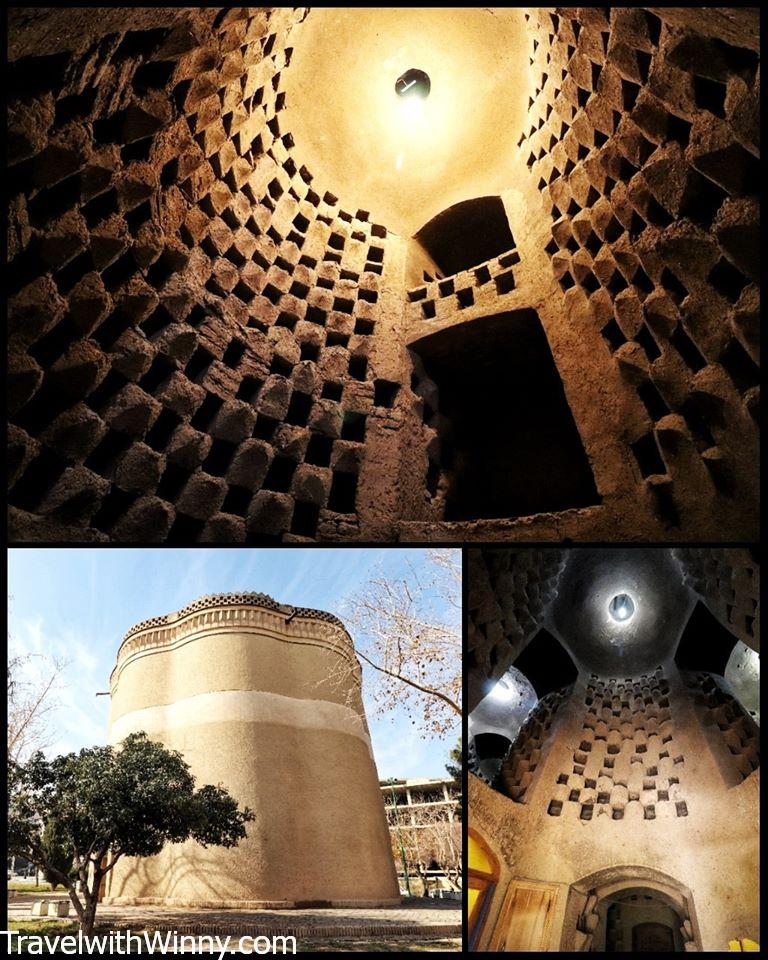
The Mardavij Pigeon Tower in Isfahan.
The Bafgh Desert
The desert we ended up visiting in Iran is the Bafgh Desert which is only 30 minutes from Yazd. This desert is really close to the city, therefore, it was quite crowded. From the blogs I read, this desert is suppose to be free. However, our driver took us to a place which cost 100,000 rials per person to enter. At this place you are able to ride camels and watch the sunset with the locals.
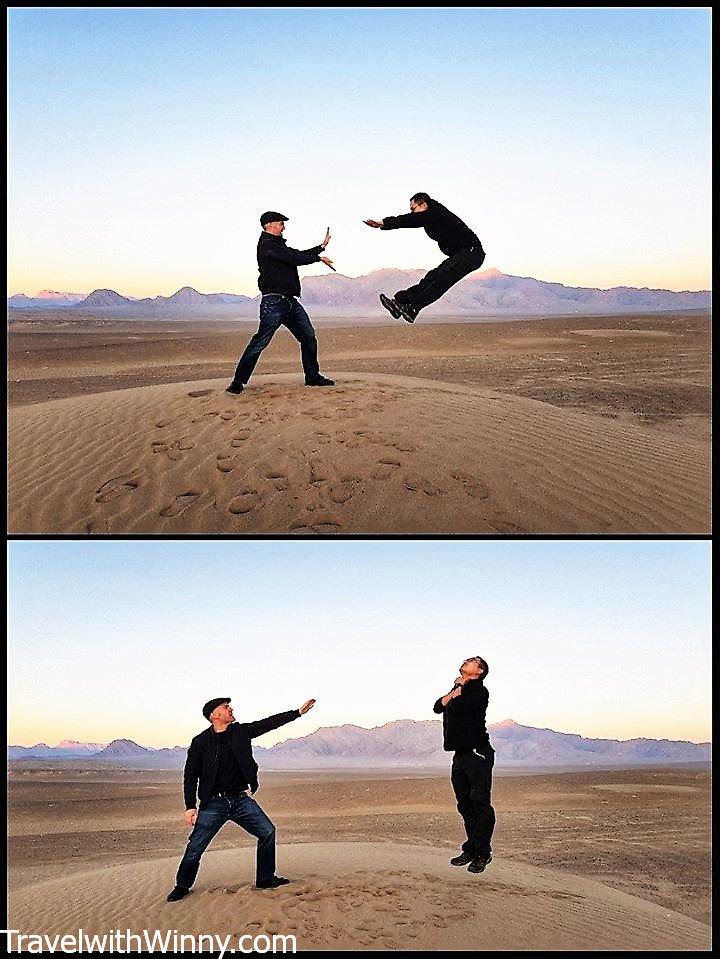
Even though the desert near Yazd isn’t the most magnificent, we still had fun taking pictures.
I won’t suggest people to come to Bafgh Desert if you haven’t experienced desert landscapes in other countries such as Namibia, Morocco or Dubai. Otherwise, it is easy to access if you want to experience deserts of Iran.
History of Yazd
The city of Yazd has been the centre of Zoroastrianism since the 3rd century. After the Arab conquest of Iran, Yazd was allowed to keep its religion by paying a levy to them. Consequently, many Zoroastrians migrated to Yazd from the neighbouring provinces, hence there’s still a sizable Zoroastrians population here today.

Yazd is one of the most prosperous oasis in the deserts of Iran.
Due to its remote location and its difficulty to access, this city remained largely untouched by foreign incursions including the Mongol invasion of the Persian Empire. It was also visited by Marco Polo who was impressed at the city’s silk-weaving industry when he passed the silk road.
Tower of Silence(Dakhme)
One of the main reasons why I wanted to visit Yazd is to see the “Tower of Silence” or “Dakhme”. It is a tower that was used by Zoroastrians for sky burial up till the 1970s. Zoroastrianism is one of the oldest religion in the world. It is one of the most influential religions in the Middle East & West Asia before Islam.

The Tower of Silence in the distance.
As I am one of those people who loves dark tourism (ie. I wanted to visit the catacombs in Paris more than the iconic Eiffel Tower), the Tower of Silence is something not to be missed! The towers itself are more like two huge circular walls built on top of the hills, which is eerily silent when you are inside.

I was a bit scared to go into the ab anbar as I wasn’t sure how far down it gets.
There are many abandoned buildings nearby, some of which are used as caravanserais for the relatives of the deceased. There is even an ab anbar- a traditional reservoir or cistern of drinking water used in the area. Unfortunately, I was too scared to go down those steps. It reminded me of the underground Basilica Cistern in Istanbul, without lights below.
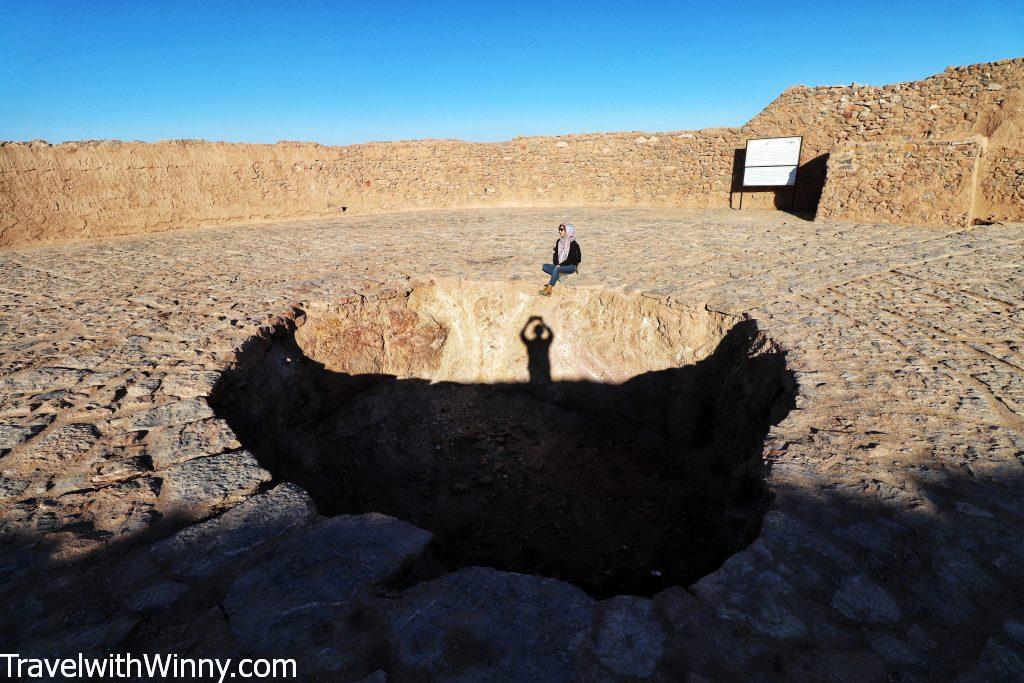
The sky burial on top of the tower. The hole in the centre is where they throw the bones in.
Visiting The Tower of Silence
There are two Tower of Silences in the area. We only went to one as we were running out of time. Apparently, the tower itself didn’t have proper steps or doors before. All of these were carved out for visitors. It was said the method for sky burial has been around for more than 3000 years.

The steps and the entrance into the Tower of Silence were only constructed later due to tourism.
The dead bodies would be carried to the inside of the tower and be placed in the open air for vultures to eat them! The bones will then be thrown into the pit, then the acid would be poured on them so the body can be dissolved in the rain.
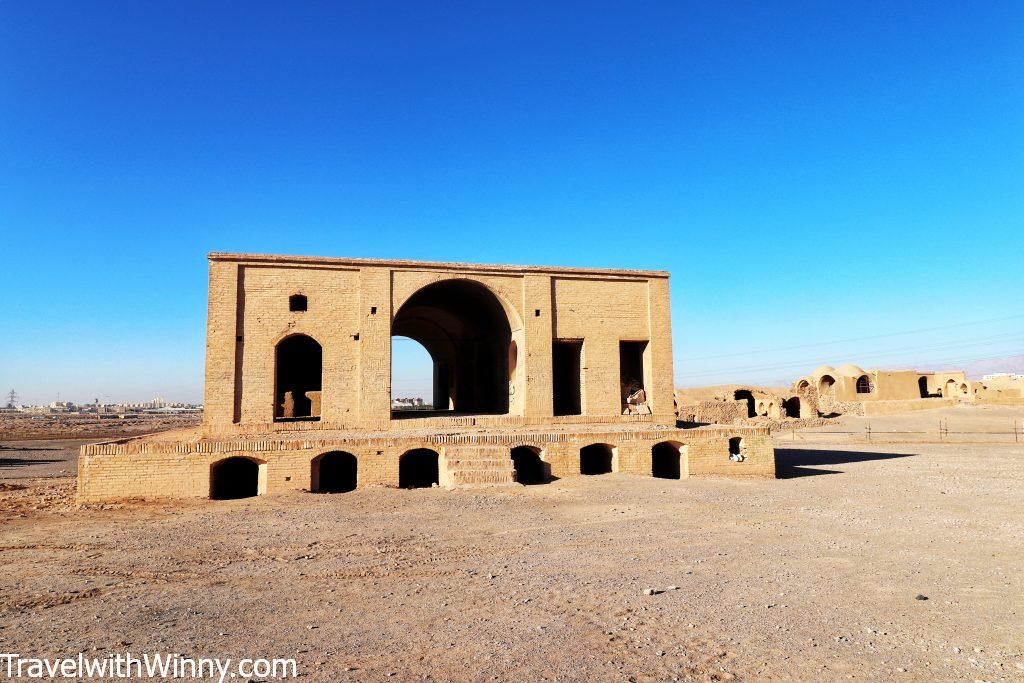
The abandoned caravanserais just outside the Tower of Silence.
The entrance to the Dakhme is 400,000 rial per person in 2019. We hired a driver for the afternoon which covers the Dakhme and the desert from 1 pm onwards for 1,800,000 rials per car. There are public transports to the Dakhme, but the private vehicle was cheap enough when shared between three of us.
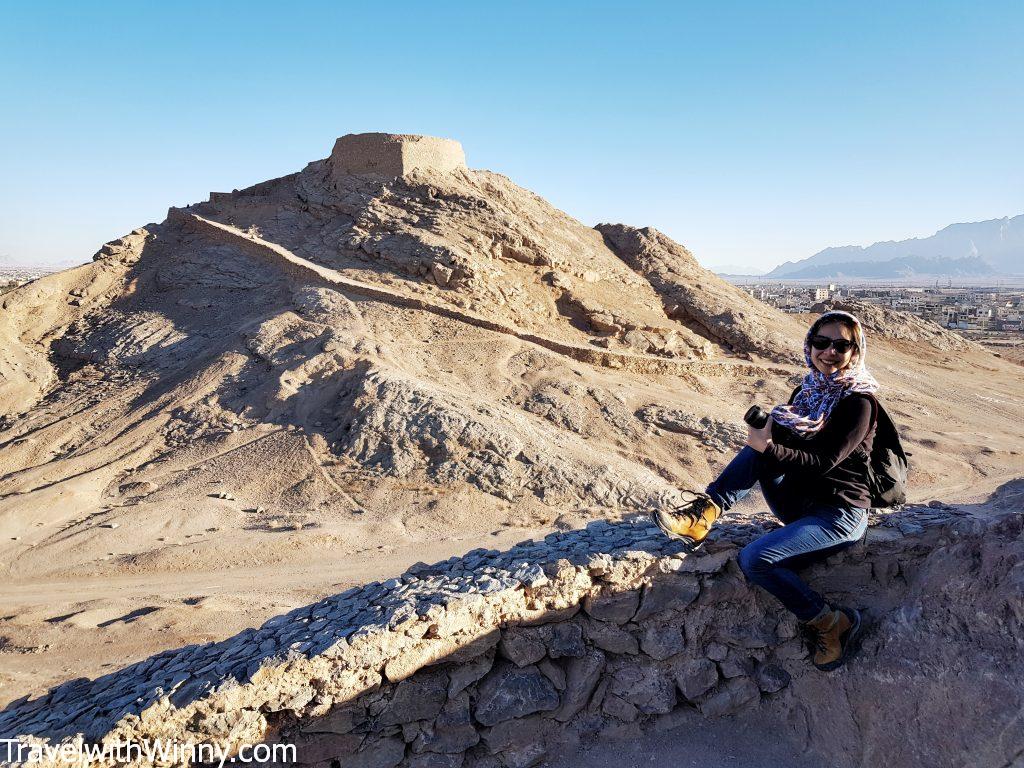
Looking at the other Tower of Silence from one of the towers.
The other attraction in Yazd that’s important to Zoroastrians is the Atashkadeh- the Zoroastrian fire temple. The fire inside has been supposedly burning since 470 AD. Although it was significant, it didn’t look particularly interesting to me, thus we didn’t end up going.
Skyline of Yazd & Windcatcher
A wind tower or windcatcher is a traditional Iranian architecture that’s used to create natural ventilation in the buildings. Often combined with ab anbars (the traditional water reservoirs), allowing water to be stored at near-freezing temperatures during summer months by using the evaporative cooling effects.

The Yazd Art House has an amazing panoramic view of Yazd skyline with several windcatchers directly behind me.
For a perfect panoramic view of Yazd skyline, I highly recommend the Yazd Art House in the old town. Not only the view is amazing, but I also quite enjoyed the food here.

The food served in Yazd Art House and its courtyard.
Masjid-e Jame (Friday Mosque)
Masjid-e Jame has the highest minarets in the country (52M high). It was built on top of an old Zoroastrian temple back in the 14th century. It has beautiful Persian mosaic tiles both inside and outside. Moreover, the mosque lights up at night which gives it a magical feel.
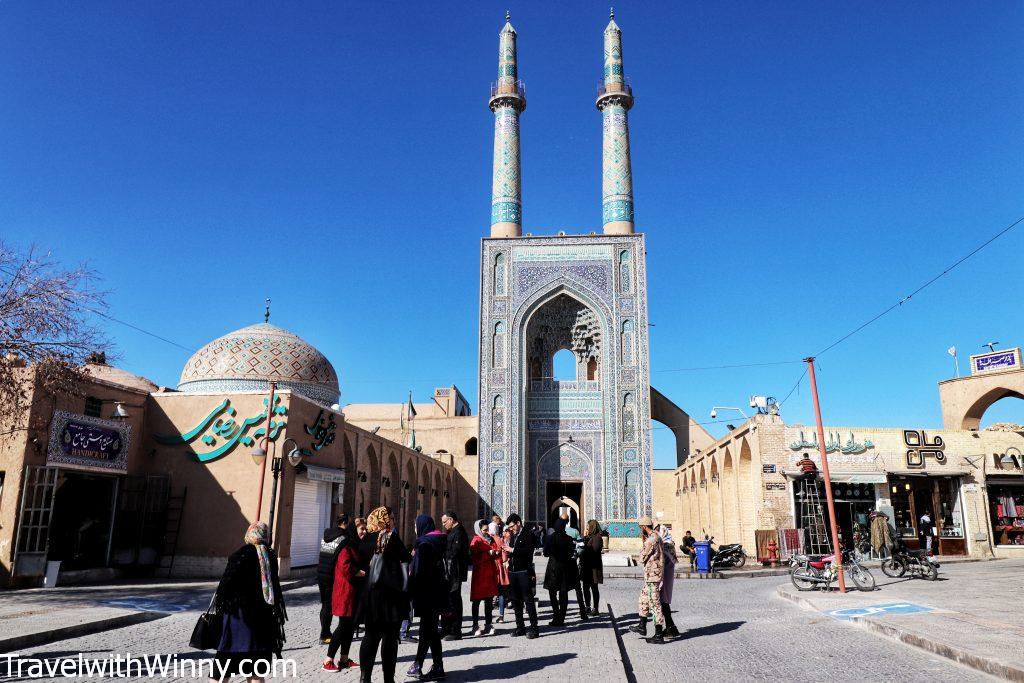
Masjid-e Jame has the tallest minarets in Iran.
Yazd Water Museum
One thing I regretted not do in Yazd is to visit the water museum. Located inside a mansion, it has a wealth of information on the local Canat water distribution system. We skipped it because we read on TripAdvisor that there are not many English explanations. However, we met this couple at the Dakhme who was more than happy to translate. Unfortunately, we were too tired after the excursion, so didn’t end up going.

There are many ab anbar in Yazd leading down towards the ancient cistern. This one was found in the market.
Amir Chakhmaq Complex
Built-in the 15th century, the Amir Chakhmaq Complex is best viewed at night. It has a mosque, a caravanserai, a bathhouse, a cold water well and a confectionery.
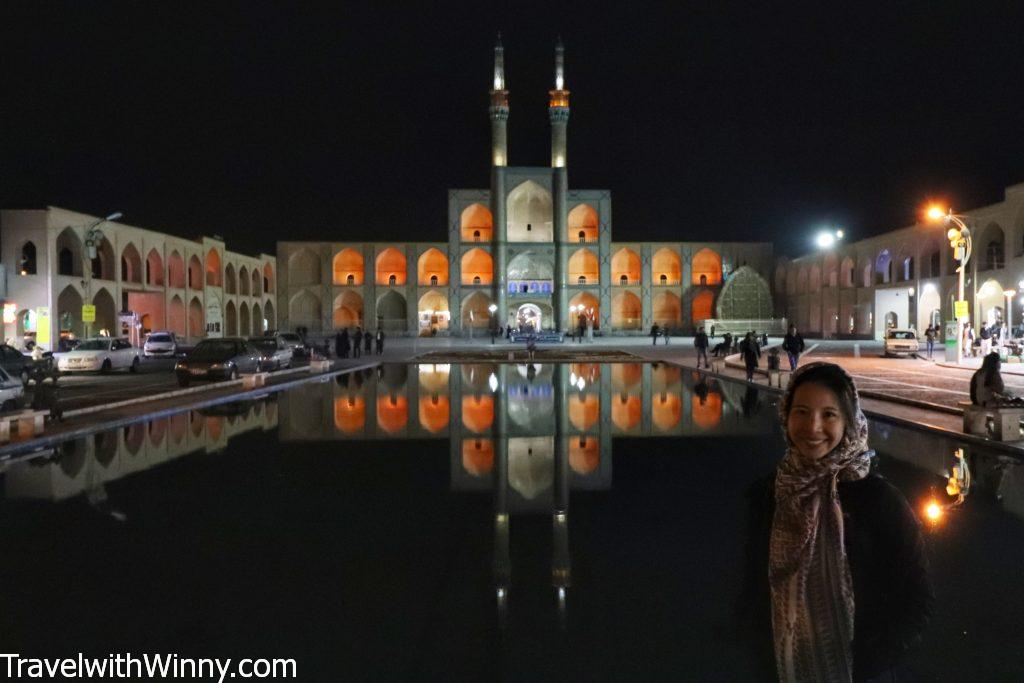
Amir Chakhmaq Complex at night with its reflection.
夜晚的阿米爾喬赫馬克廣場以及池中倒影。
Saheb Al-Zaman Zurkhaneh
If come at the right time, this probably would be one of the most interesting things you would see in Iran. This ab anbar (water reservoir) was built in the 16th century and is now a local gym for a UNESCO sport called Zurkhaneh. The men here exercise with huge wooden clubs to build muscles. Tourists can pay a fee to watch people exercise. Unfortunately, we came at the wrong time, so no one was there.
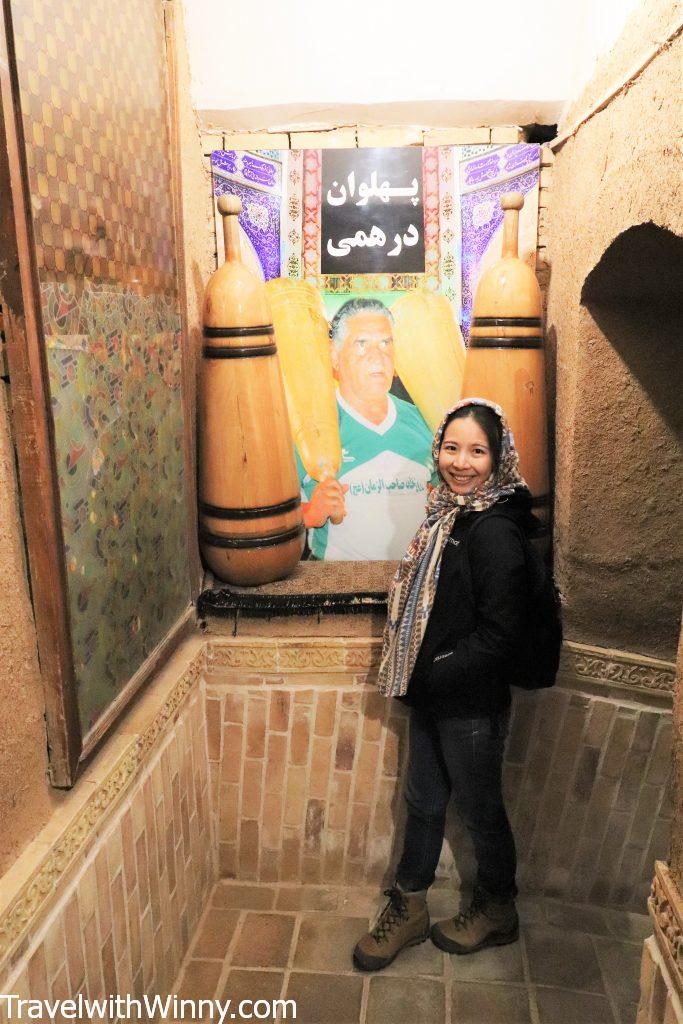
As seen behind me, these huge wooden clubs are what people used to exercise.
Accommodation:
As Booking.com is not available in Iran, we have to book through Hostelworld.com. We stayed in Delkhash Guesthouse, which has a score of 9.9/10! It is located inside the old town with a beautiful courtyard.
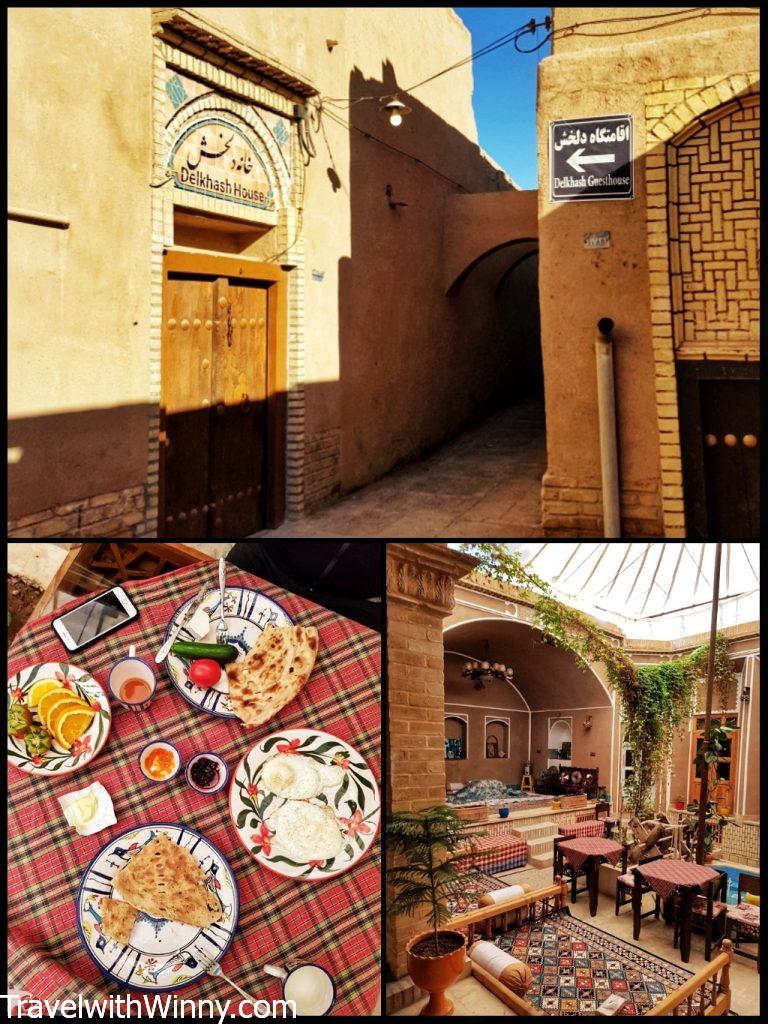
The breakfast provided by Delkhash Guesthouse and its courtyard.
Transportation in Yazd:
- If you have an Iranian sim card, then you can use the local rideshare APP- SNAPP.
- The VIP bus from Shiraz to Yazd was 510,000 rial per person.
- The VIP bus from Yazd to Isfahan was 340,000 rial per person or 310,000 rials for the normal bus.
- The taxi fare from Yazd bus station to the old town was 150,000 rial when using SNAPP.

The locals are very friendly, the boy on our way to Yazd insisted to take a selfie with us.
If you enjoy this blog, don’t forget to follow us on IG @ travelwithwinny and see our Iranian stories! Or follow our Facebook page @ Travel with Winny.
Great article 🙂
Love from Iran 🙂
Please checkout our articles on Iran destinations and attractions too,
https://cheetah-adventures.com/iran-destinations/
Thanks! Hope people can find useful information in your site!
OMG I see you visited the best part and also untouched places of Yazd. good to see you enjoyed your travel to Iran and thanks for sharing.
Thank you for your comment, that’s very sweet of you! Yes we loved Iran!